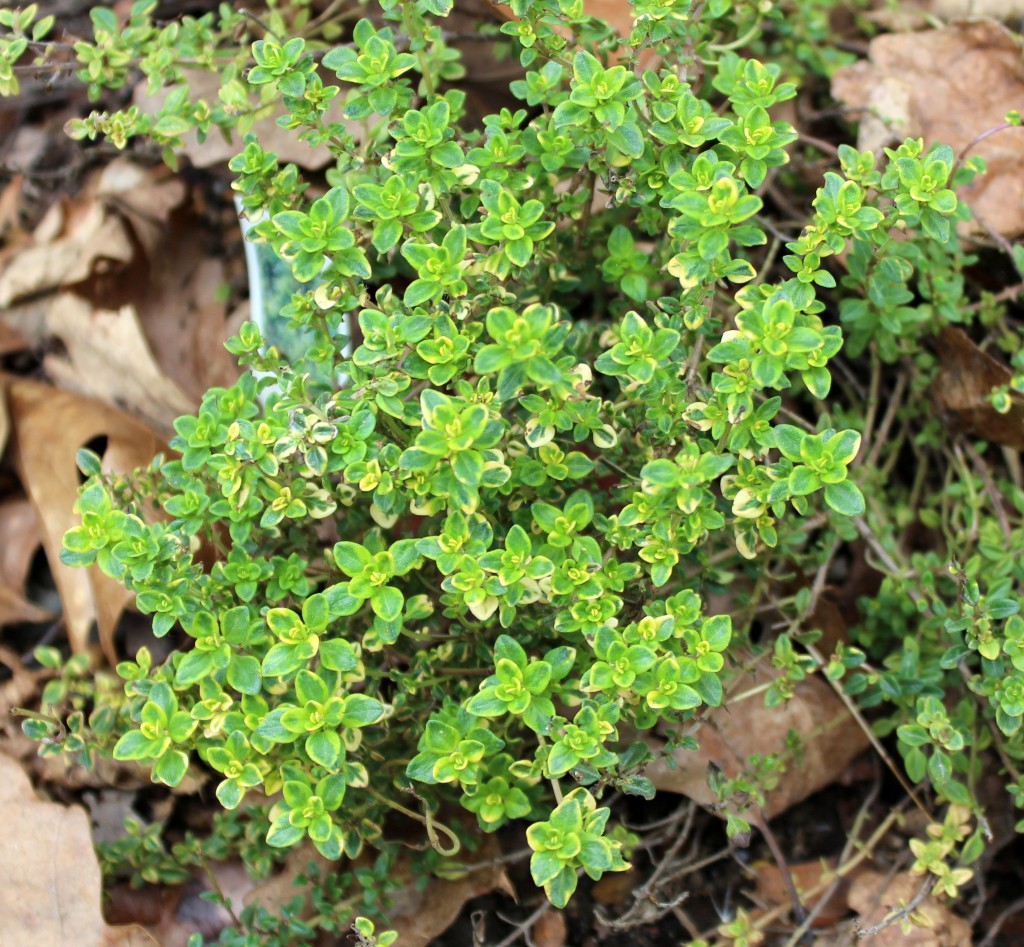Herb: Thyme
Thyme, Thymus vulgaris, is a culinary herb used to flavor meats and vegetables.
Thyme varieties include English Thyme, German or Winter Thyme, and French thyme, among others. Thyme is a low-growing herb that does well when planted in full sun. Depending on variety the flowers are white to light pink to light purple.
Thyme Characteristics
- perennial
- small shrub reaching to 10 inches tall, forming mats
- grayish, small leaves are oval shaped
- leaves fragrant
- light purple or white flowers at growing tips and in upper leaf axils
- cultivated in gardens for culinary uses
Thyme Uses
- medicinal
- culinary
- gardening
Growing Thyme
Growing conditions: Thyme is grown best in sunny locations and needs well-drained soil.
Light: sun
Height: 12 inches
Spacing: 12 inches
Planting comments: Seed directly after the danger of frost has passed for your area. Seeds germinnate between 60 and 75 degrees F.
Where to Buy Thyme
Thyme is available as seeds or plants. Depending on the time of year you may be able to find a plant at your nearby garden center. In case they’re are not available locally, here are some places that offer herb seeds and herb plants.
- Abundant Life Seeds Cottage Grove, OR
- Artistic Gardens / Le Jardin du Gourmet St. Johnsbury Center, VT
- Baker Creek Heirloom Seeds Mansfield, MO
- Bluestone Perennials, Inc. Madison, OH
- BorgheseGardens.com Gautier, MS
- Bountiful Gardens Palo Alto, CA
- Companion Plants Athens, OH
- Ed Hume Seeds Puyallup, WA
- Eden Organic Nursery Services, Inc. Davie, FL
- GreenDealer Exotic Seeds Louisville, KY
- Heirloom Seeds West Elizabeth, PA
- Henry Field Seed and Nursery Co. Aurora, IN
- High Altitude Gardens Cornville, AZ
- Irish Eyes Garden Seeds Ellensburg, WA
- Jim Johnson, Seedman Gautier, MS
- John Scheepers Kitchen Garden Seeds, LLC. Bantam, CT
- Johnny’s Selected Seeds Winslow, ME
- Jung Quality Seeds Randolph, WI
- Logee’s Greenhouses, Ltd. Danielson, CT
- NESEED.com Hartford, CT
- Nichols Garden Nursery Albany, OR
- Ornamental Edibles San Jose, CA
- Otto Richter and Sons Limited. Goodwood, ON, Canada
- Peaceful Valley Farm Supply, Inc. Grass Valley, CA
- Pepper Gal Fort Lauderdale, FL
- Peters Seed and Research may be out of business,
- Pinetree Garden Seeds New Gloucester, ME
- R.H. Shumway’s Randolph, WI
- Redwood City Seed Co. Redwood City, CA
- Renee’s Garden Seeds Felton, CA
- Seed Savers Exchange Decorah, IA
- Southern Exposure Seed Exchange Mineral, VA
- Stokes Seeds Inc. Buffalo, NY
- The Cook’s Garden Warminster, PA
- Thompson and Morgan Jackson, NJ
- Underwood Gardens Chino Valley, AZ
- Veseys Seeds Ltd. Calais, ME
- Victory Seed Company Molalla, OR
- W. Atlee Burpee & Co. Warminster, PA
- Willhite Seed, Inc. Poolville, TX
In case you can’t find what you’re looking for commercially, take a look at some of the online seed swap sites where you can find many unusual plants and common ones, too.
Chef’s Article: Thyme Leaves and Flowers Flavor Savory Dishes
by Naomi Gallagher
Thyme is a herb from a small, low-growing shrub, Thymus vulgaris, which is a member of the mint family, Lamiaceae. It may be called English thyme, French thyme, common thyme or garden thyme. Native to the Mediterranean region, thyme is now widely cultivated in Europe and North America for its essential oil and for the herb as a flavoring agent.
Thyme is a small perennial plant with small leaves and tiny purple flowers. The leaves and blossoms are used as the herb. Leaves are oval-shaped and lie opposite one another. In the warmest locations thyme shrubs can reach a foot and a half tall. In northern climates thyme may only be six or eight inches tall. Some varieties are more shrub-like and others have more of a trailing habit.
Thyme is grown ornamentally in rock gardens, along walkways and among flagstones. It releases its scent when stepped upon, yet the plant is hardy enough to not sustain damage from this kind of wear. Trailing varieties can produce a nice display when allowed to vine along and drape over garden walls.
Thyme is propagated via seed that can be direct sown or started early indoors. Thyme can also be propagated by layering, where the side stems of an existing plant are covered with soil while leaving the tops exposed. Rooting will take place at the leaf nodes that are covered by the soil. When the covered parts have rooted and show signs of growth, the new plant can be transplanted to another location. Stem cuttings and root division are other techniques used to propagate thyme.
The leaves and flowering tops are used to add flavor to foods such as meat and poultry, herb butter, sauces, soups, salads, tomatoes, pasta, egg dishes, cheeses, stuffings, fish and clam chowder. Fresh or dried, the leaves and flowers are usually added to other herbs and spices. Thyme is typically an ingredient in Italian seasoning herb blends and in herb and spice mixtures, like poultry seasoning.
Thyme contains about 1% essential oil with thymol being the main ingredient. Also known as thyme camphor, thymol is used commercially in the food, cosmetic and pharmaceutical industries. Benedictine liqueur is flavored with oil of thyme.
Thymol has been used in medicine for many centuries for its antiseptic and anesthetic properties. It’s used in dentistry for both these characteristics. Thymol is the main active ingredient in Listerine mouthwash. Natural hand-sanitizers of the alcohol-free kind use thymol as the active ingredient.
Thyme tea can be used as an expectorant and soothing gargle to reduce the inflammation associated with sore throats, coughs and bronchitis.

